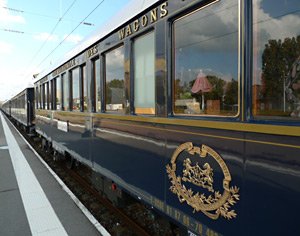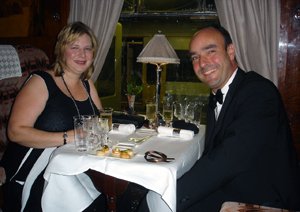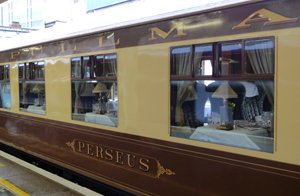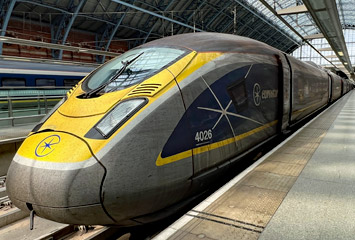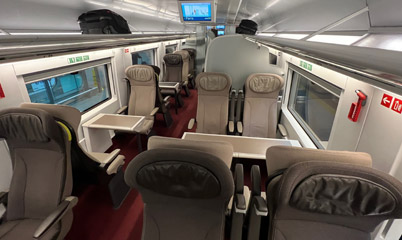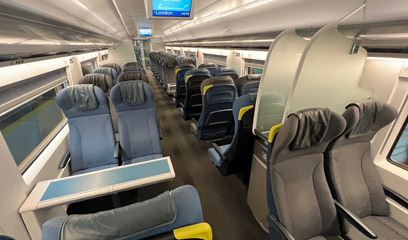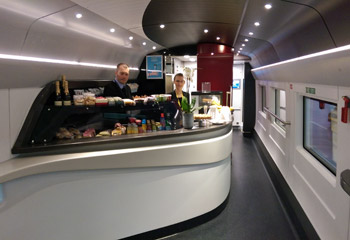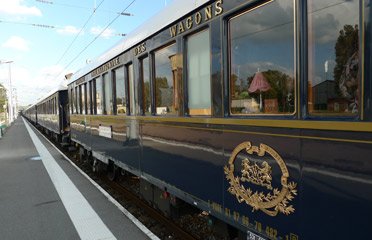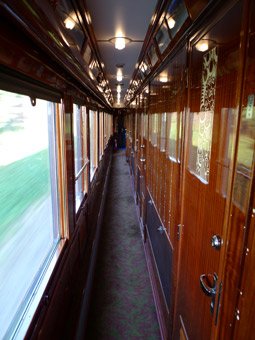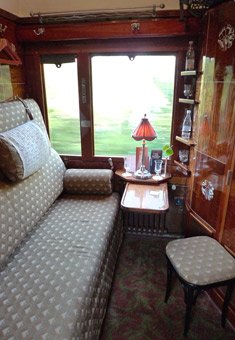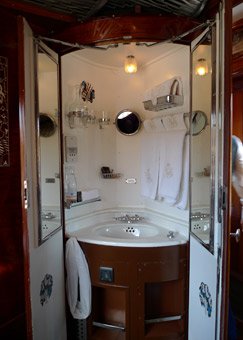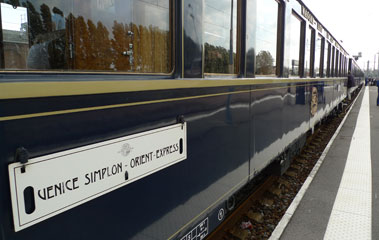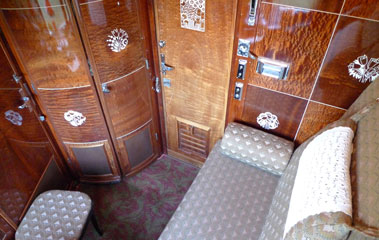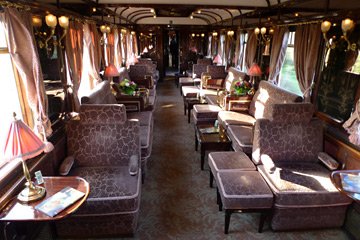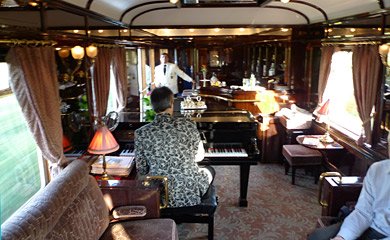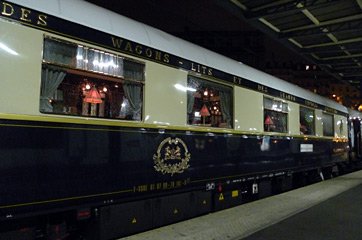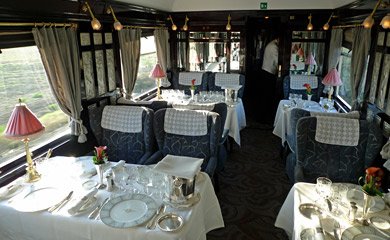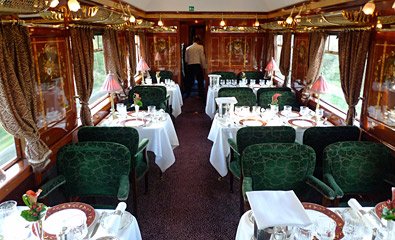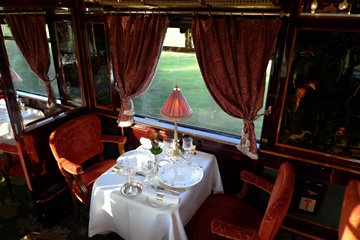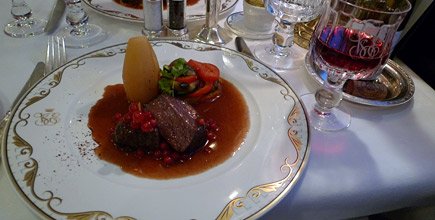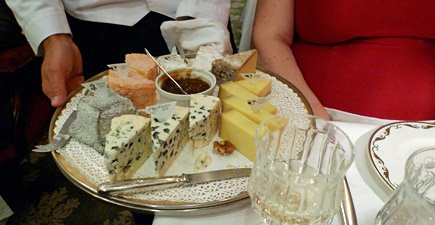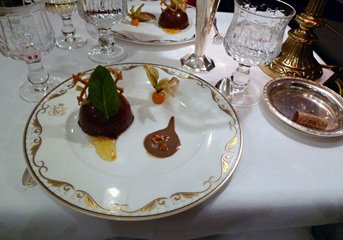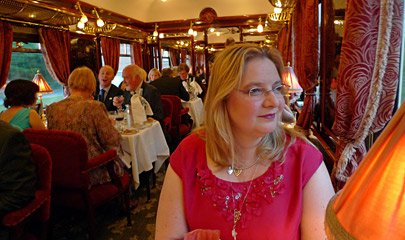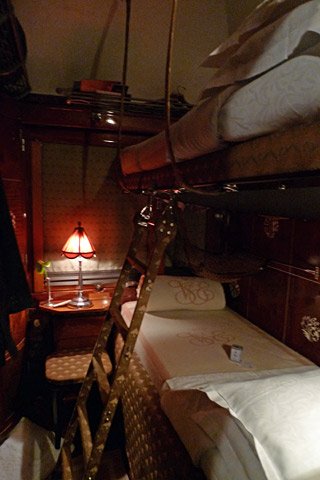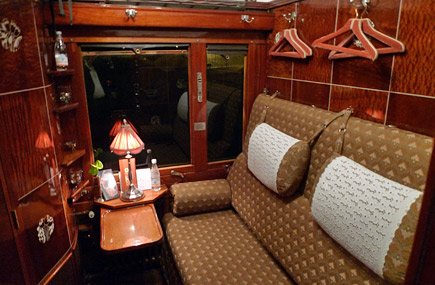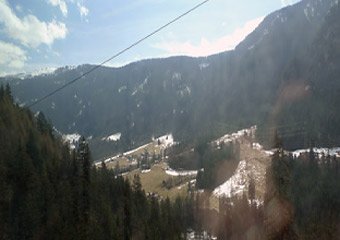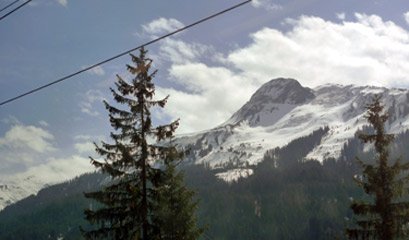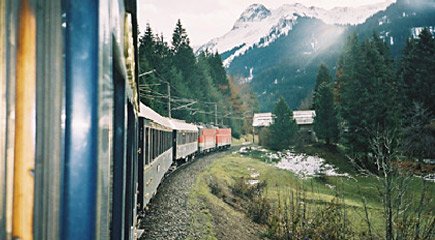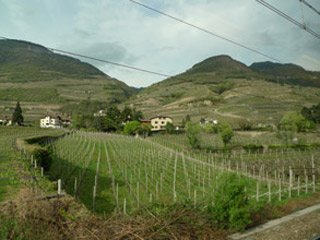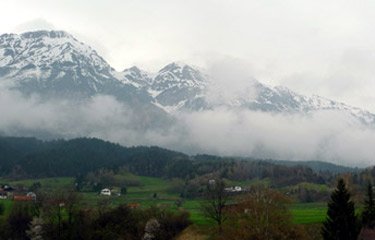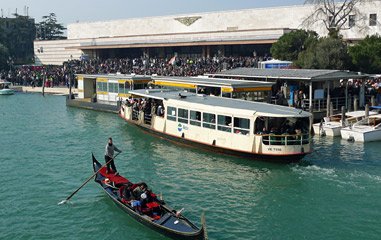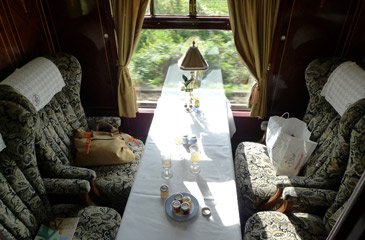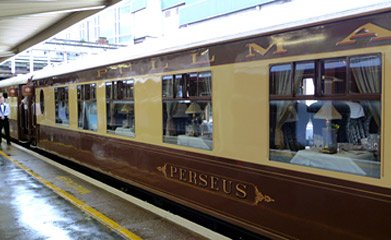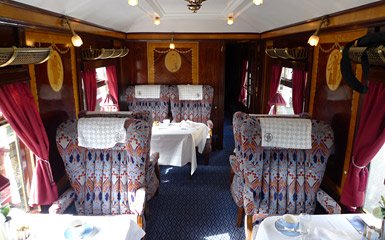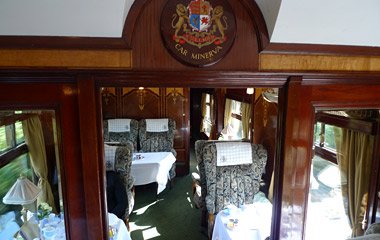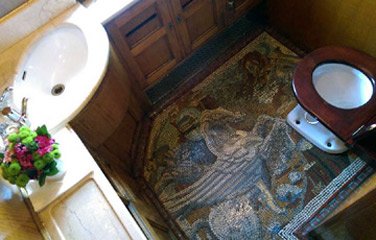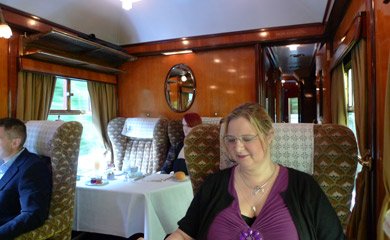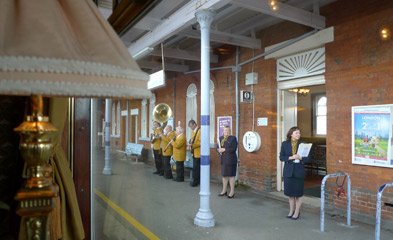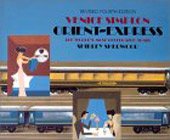|
|
The luxury vintage train to Venice
If you can afford it, the Venice Simplon-Orient-Express is the most romantic and luxurious way from London or Paris to Venice. Its vintage carriages are a delight and the food & on-board service are truly world class. Unlike many expensive tourist experiences, this train really does live up to its five-star and you won't be disappointed. Watch the video.
![]() What is the Venice
Simplon-Orient-Express?
What is the Venice
Simplon-Orient-Express?
![]() Can a 24-hour train ride
really be worth
over £3,000?
Can a 24-hour train ride
really be worth
over £3,000?
![]() Video guide:
A journey on the VSOE
Video guide:
A journey on the VSOE
![]() Orient Express books, gifts &
souvenirs
Orient Express books, gifts &
souvenirs
![]() Is
this the original Orient Express?
Is
this the original Orient Express?
![]() Station guide: Paris Est, Venice
Santa Lucia
Station guide: Paris Est, Venice
Santa Lucia
![]() Also by Belmond: Eastern & Oriental
Express, Belmond Royal Scotsman
Also by Belmond: Eastern & Oriental
Express, Belmond Royal Scotsman
The Venice Simplon-Orient-Express
The Venice Simplon-Orient-Express (VSOE) is a privately-run train of beautifully-restored 1920s, 30s & 50s coaches, providing a 5-star luxury train experience between London, Paris, Verona & Venice, running roughly once a week from March to November. The journey from London to Venice takes 24 hours and costs over £3,300 per person one way, including meals.
The train is run by Venice Simplon-Orient-Express (VSOE) Limited, part of Belmond, who also operate the equally luxurious Eastern & Oriental Express from Singapore to Bangkok, the Royal Scotsman cruise train and the PeruRail trains to Machu Picchu. The VSOE should not be confused with the real Orient Express, the true descendant of the original 1883 Orient Express, a regular scheduled train which was finally withdrawn on 12 December 2009, see here for an explanation.
The Venice Simplon-Orient-Express also runs occasional trips to Florence, Rome, Krakow, Budapest, Stockholm and even Istanbul once a year, in August.
Important changes since 2024
2023 was the last season in which VSOE passengers travelled from London Victoria to Folkestone by British Pullman, got ferried through the Channel Tunnel by road coach and boarded the Continental train at Calais. Since 2024, the VSOE only operates between Paris and Venice, with connections to/from London St Pancras by Eurostar. No more British Pullman. This is down to Brexit and delays caused by longer border checks. This made the Folkestone-Calais coach transfer increasingly unreliable which in turn delayed the departure of the VSOE train from Calais. A great shame.
Southbound dates, London to Venice
2026: 5 March. 2, 9, 25 April. None in May. 7, 15, 25, 29 June. 9 July. 17, 29 August. 4, 13 September. 15, 20 October. 12, 23, 28 November. 20 December.
Northbound dates, Venice to London
2026: 3, 19, 24, 31 March. 23, 28 April. 8, 23 May. 13, 27 June. 4, 14 July. 20, 27 August. 2, 8, 17, 23 September. 12 October. 3, 17, 26 November. 12 December.
Timetable 2026
The Eurostar shown above is only the suggested connection, you can choose any Eurostar you like and spend some time in Paris.
How much does it cost?
Solo travellers: The prices above are per person for two people sharing a 2-berth compartment. If you're a solo traveller, sole occupancy costs significantly more.
Children: Infants under 2 sharing a berth travel free. Children under 12 sharing a compartment with a full-fare-paying adult get a 20% reduction.
The extra-cost cabin suites & grand suites are explained below.
Can a 24h train ride really be worth £3,500?
The Man in Seat Sixty-One says: "I admit I doubted that any 24 hour train journey could be worth that. I was forced to change my mind after a journey from London to Verona on the VSOE in October 2003. I thought I knew what to expect, but the Venice Simplon-Orient-Express exceeded all expectations, with its superbly restored coaches, excellent and plentiful food, beautiful Alpine scenery and the world class but surprisingly friendly and unpretentious service from the train's staff. And I got far more than I bargained for on that trip. Nicolette and I had been going out for just 6 months and we boarded the train with nothing planned or premeditated, but it weaved its special magic. Our son's name was decided at night in our sleeper somewhere in France, and next day as the VSOE headed through the Brenner Pass in driving October snow we accidentally got engaged. And here I am now with a wife, two kids, four cats and one mildly deranged cockapoo. Powerful magic this train, handle with care. I'd be the first to point out that the VSOE is not the 'original' Orient Express as there's no such thing, but this is one beautifully-restored and truly historic train, superbly run and an utter pleasure to travel on. If you can afford it, this is one train you shouldn't miss."
Day trips & dinner trips
|
Journey suggestions
Which is better, southbound or northbound?
Either is great, but in my opinion the southbound has the edge. Although the northbound journey tends to be less popular, so often has better availability and sometimes better rates. But personally, I feel the journey works best going out from London with the arrival in Venice over the causeway a fitting climax. You'll also see more of the Alpine scenery in daylight in the morning from a southbound train than (depending on the time of year) in the evening from a northbound train.
One way VSOE, one-way TGV & Eurostar
If you only take the Venice Simplon-Orient-Express one-way, you don't need to fly the other. Take Eurostar from London to Paris in 2h15, have lunch at the amazing Train Bleu restaurant inside Paris Gare de Lyon, then take the afternoon TGV or Frecciarossa from Paris to Turin in 5h40, a comfortable & scenic journey through the French Alps, see the video & photos here, arriving in the evening. Stay overnight in Turin, and next morning take a high-speed train from Turin to Venice in around 4h30. This works equally well in either direction, see the London to Italy by train page for all you need to know.
For the ultimate scenic ride between London & Venice, take Eurostar & a TGV-Lyria to Zurich on day 1, then take the wonderful narrow-gauge Bernina Express through the Swiss Alps to Tirano with connections for Venice on day 2, see the Bernina Express page. You can easily arrange this yourself, or you can ask custom-made tour agency www.railbookers.co.uk to arrange both your Venice-Simplon-Orient-Express trip and your scheduled trains and suggest some excellent hotels in Venice.
VSOE to Krakow, Budapest, Prague, Rome & Istanbul
As well as its regular London-Paris-Venice route, the Venice Simplon-Orient-Express runs occasional departures to Krakow, Vienna, Budapest, Prague, Rome, Stockholm and sometimes even Istanbul (London to Istanbul usually in late August, 5 nights for around £7,000 pp), see www.belmond.com/venice-simplon-orient-express or call Railbookers.
Day trips in the UK by Belmond's British Pullman & Northern Belle
The VSOE's British Pullman cars run a regular programme of day-trips, dinner trips and excursions around the British Isles, mostly around London and typically £210-£420 per person. Belmond also used to own (but have now sold) a set of more modern cars dating from the 1970s converted to classic Pullman standard which is used on Northern Belle excursions in the north of England, see www.northernbelle.co.uk for routes, dates, prices & tickets.
How to buy tickets
Option 1, call Railbookers
-
Railbookers are train specialists who often have special rates for the Venice Simplon-Orient-Express. They can also arrange hotels and regular scheduled European trains to create a customised trip - for example Eurostar & high-speed TGV-Lyria from London to Zurich, 1 night at the superb Hotel Schweizerhof (first introduced to me by Railbookers, now a personal favourite), onward travel through the Alps via the wonderfully scenic Gotthard Pass route to Venice, 3 nights 4-star hotel in Venice, then by fabulous Venice Simplon-Orient-Express from Venice to London. Railbookers take good care of their clients, and they now have offices in the UK, US & Australia.
 UK call 0207 864 4600,
www.railbookers.co.uk.
UK call 0207 864 4600,
www.railbookers.co.uk.
 US call free 1-888-829-4775,
www.railbookers.com.
US call free 1-888-829-4775,
www.railbookers.com. Canada call free 1-855-882-2910,
www.railbookers.com.
Canada call free 1-855-882-2910,
www.railbookers.com. Australia call toll-free 1300 971 526,
www.railbookers.com.au.
Australia call toll-free 1300 971 526,
www.railbookers.com.au.
 New Zealand call toll-free 0800 000 554 or
see
website.
New Zealand call toll-free 0800 000 554 or
see
website.
Option 2, call Tailor Made Rail
-
UK-based Tailor Made Rail can organise a trip on the Venice Simplon-Orient Express. Call their dedicated seat61 phone line 020 3778 1461 and quote seat 61 when booking. From outside the UK call +44 20 3778 1461. Lines open 09:00-17:30 Monday-Friday. See www.tailormaderail.com/trains/venice-simplon-orient-express.
Option 3, book at belmond.com
-
You can also buy tickets at www.belmond.com/venice-simplon-orient-express. If you feel like packing some lucky loved one off to Paris or Venice, you can buy Venice Simplon-Orient-Express gift certificates. Double cabin or Suite cabin? See the explanation here. However, I'd call Railbookers or Tailor Made Rail before booking, as sometimes they can offer VSOE plus hotels more cheaply than a train-only booking with Belmond.
What's a journey on the Venice-Simplon-Orient Express like?
![]() London to Paris by Eurostar - used
for London-Paris from 2024
London to Paris by Eurostar - used
for London-Paris from 2024
![]() Paris to Venice by Venice
Simplon Orient Express
Paris to Venice by Venice
Simplon Orient Express
![]() Scenery through Switzerland, Austria & Italy
next day
Scenery through Switzerland, Austria & Italy
next day
![]() The British Pullman train
- used for excursions, no longer used for London-Venice
The British Pullman train
- used for excursions, no longer used for London-Venice
London to Paris by Eurostar
From 2024, passengers no longer use the British Pullman from London to Folkestone, and the Continental train no longer starts from Calais. From 2024 onwards, passengers take Eurostar from London St Pancras to Paris Gare du Nord, which is a short 7-minute walk from Paris Gare de l'Est. I expect Belmond will bus you from station to station, but it really is just a 7 minute walk!
See more about the Eurostar journey here. Passengers bound for the VSOE travel in Business Premier, a meal with wine and champagne is served at your seat. There are power sockets at all seats & free WiFi.
The Venice Simplon Orient Express
In the evening at Paris Gare de l'Est you board the VSOE's continental train of restored blue-and-gold 1920s Wagons-Lits sleeping-cars for Innsbruck, Verona & Venice. You've time to take photos.
The sleeping-cars
Historic compartments - authentic, see car layout
Your sleeper attendant greets you at the door and shows you to your compartment. The VSOE's sleeping-cars are mostly classic 1929-vintage LX-series cars with ten 2-berth compartments that convert to private sitting rooms with sofa and small table for daytime use. With their inlaid wood marquetry, the LX-types were the most luxurious sleeping-cars ever built for La Compagnie Internationale des Wagons-Lits (CIWL, the original operator of the Orient Express), and the VSOE's restored LX-series cars were originally used on various CIWL trains including the Calais-Paris-Nice Train Bleu, the Paris-Rome Rome Express, the Paris-Berlin-Warsaw-Riga Nord Express. One Paris-Istanbul sleeping-car and the Calais-Trieste sleeping-car of the Simplon Orient Express would also have been an LX-type in the 1930s.
VSOE also own two earlier 1927-built S-series cars which had less fancy woodwork and slightly smaller compartments, but they were both gutted in 2018 to create Belmond's modern Suites & Grand Suites. In the 1930s, the Calais-Istanbul sleeping car & Calais-Athens sleeping-car of the Simplon Orient Express would normally have been an S-type.
Sleeper facilities: Each historic compartment has a large sofa convertible to an upper and lower berth at night, a footstool, small folding table. There's a broad luggage rack towards the ceiling capable of taking fairly large items. In a corner (either by the door or the window), two doors open to reveal a washstand with soap, towels, flannels and hot & cold water. Mineral water, slippers & dressing gown are provided, and (a modern addition) there are two plug sockets of the normal 2-pin European type. Authentic 1920s sleeping-cars don't have en suite toilets or showers, they also didn't have air-conditioning, but this has now been fitted. You can still wind the window down, great for reflection-free photos of the scenery.
The correct term is 'Compartment' not 'Cabin': These sleeper compartments are described on the Belmond website as historic cabins. Trains don't have cabins, that is a nautical term used for a room on a ship. The correct term on a train is a compartment. Travellers in the 1920s & 1930s would have known this perfectly well, travellers unused to trains & ships now seem to use 'cabin' for everything and even Belmond don't seem to know the correct term.
Suites & Grand Suites - not authentic
For the 2018 season, Belmond created 3 luxurious Grand Suites with double bed, parlour area and en suite shower & toilet, they also now offer several smaller Suites with either twin or double beds and en suite toilet & shower. These modern suites were created by taking one of the VSOE's two historic S-type sleeping-cars (car 3425, the car my wife & I got engaged in, as it happens), completely gutting the car's original 1920s interior (it had ten 1 or 2 berth compartments with washbasin) and building these new suites from scratch inside the empty bodyshell. The suites are a modern creation for the 21st century tourist market and completely unauthentic - the real Orient Express of the 1920s and 1930s would have no suites, no showers, and no en en suite toilets, just a chamber pot kept in a hidey-hole under the sink (hence the famous CIWL sign, Sous le lavabo se trouve une vase...). In fact the Orient Express wouldn't have had a bar car or piano either, just sleeping-cars and a restaurant car. If you want the authentic 1920s/30s experience, save your money and stick with the basic, original, historic LX sleeper compartments. Check prices for the suites & grand suites online at www.belmond.com or call Railbookers.
Piano-bar
The place to go before or after dinner is the VSOE's lively bar car, with lounge area, cocktail bar and piano. Needless to say, the real Orient Express even in its 1920s & 1930s heyday would have not have had any such fripperies as a bar or lounge, let alone a piano, just sleeping-cars and a restaurant. It was a much more work-a-day train than most people imagine. The piano-bar-lounge has been created for modern-day tourists out of a former Wagons-Lits Company pullman car built in 1931 - but it's still great place to mingle. You'll find a small VSOE Boutique counter in these cars.
The 3 restaurant cars
The Venice Simplon-Orient-Express has three restaurant cars, each with unique decor:
The Cote d'Azur was originally a 1st class Pullman car built in 1929, first used on the Cote d'Azur Pullman Express. With lovely Lalique glass panels, it's my favourite.
The Etoile du Nord restaurant car was built in Birmingham in 1926 for the Paris-Brussels-Amsterdam Etoile du Nord Pullman train, it was later used on the Edelweiss from Amsterdam to Switzerland and the Lusitania from Madrid to Lisbon.
L'Orientale was originally a Pullman kitchen car, built in Birmingham in 1927 and also used on the Etoile du Nord and later the Lusitania, and it features Chinese-style lacquer wall panels.
Soon after departure the Maitre d' comes down the sleeping-cars handing out dinner reservations. You'll be allocated a restaurant car but feel free to request a table in your favourite. Make sure you experience two different ones at dinner and lunch.
Dinner in the diner
Meals are included in the fare on the VSOE, and the food is truly excellent. Drinks on the Continental train cost extra, reckon on the cheapest half bottle of wine costing €35, a full bottle €50. A dress code applies in the evening, for men a dark suit is essential, but the majority of passengers bring a dinner jacket and bow tie as dressing up is part of the fun. You can't be over-dressed on the VSOE!
Time for bed
You'll return from dinner to find your compartment converted into a bedroom by the sleeper attendant, with upper and lower berths. The beds are the most comfortable I have ever slept in on a train, in fact they're more comfortable than many hotel beds. There are toilets at each end of the corridor. The door locks securely with both a lock and security chain.
Scenery next morning in Switzerland, Austria & Italy
In spite of its name, the Venice Simplon-Orient-Express no longer uses the Simplon route via Lausanne, Brig & Milan. Instead, it runs overnight from Paris to Switzerland and you'll probably wake up just beyond Zurich. When I last took it, I found the train running alongside the sparkling waters of the Zürichsee or Walensee with a breathtaking mountain backdrop, heading for the Arlberg Pass then the Brenner - although from 2016 it travels via the Gotthard Pass to Milan, only using the Brenner and Arlberg northbound. A Continental breakfast of excellent coffee, juice and fresh croissant is served on a tray in your compartment by your sleeper attendant. When I took it, the train clipped a corner of Liechtenstein and entered Austria via the wonderfully scenic Arlberg Pass - which once gave its name to the Paris-Switzerland-Vienna Arlberg Orient Express which used this route. The VSOE turned right after Innsbruck, and as a 3-course lunch was served in the restaurant cars we headed into Italy via the almost equally scenic Brenner Pass to Verona, passing Padua and Venice Mestre before finally rumbling slowly across the 2km causeway to Venice Santa Lucia station on the banks of the Grand Canal in central Venice, just 15 minutes walk from the famous Rialto Bridge or 25 minutes walk from St Mark's Square.
Video guide: Venice Simplon-Orient-Express
More videos: Arlberg Pass scenery video Brenner Pass scenery video
These two videos show the scenery through the Arlberg and Brenner Passes which you'll see over breakfast and lunch on the Venice Simplon-Orient-Express. They were shot from scheduled trains on the route, but the scenery is of course the same!
Travel tips
-
Dress up! You'll need (for men) at least a dark suit and tie for dinner on the VSOE Continental train, but many travellers change into a dinner jacket with bow tie for dinner - indeed, you may feel under-dressed in just a suit. A significant number of travellers dress up in 1920s or 30s style, you won't feel out of place if you do! During the day dress code is smart-casual, you can't wear jeans on the VSOE.
-
Ask for your favourite restaurant for dinner - and a different one for lunch next day. There are three restaurants on the VSOE continental train, each unique. The Maitre d' will make a dinner reservation for you, feel free to request a table in your favourite restaurant - my favourite is the Cote d'Azur with its lovely glass panels by Lalique. Next day, request a table in one of the other two, to experience a different car.
FAQ
-
Are there showers? Not in the original authentic 1920s sleeper compartments, no. These were built in an era when hotel rooms didn't have en suite bathrooms, people survived without taking a shower every few hours and Sunday night was bath night whether you needed it or not. The sleeper compartments have a washstand with hot & cold running water which was a luxury for the 1920s, when many hotel rooms didn't even have this. Incredibly, Belmond tell me that the lack of en suite showers is the biggest thing that surprises many VSOE travellers even though they know they're going on an authentic 1920s train! However, the more expensive suites and grand suites have en suite toilet & shower, as these are a modern innovation, they are not original or authentic.
-
Is there WiFi? The train now has WiFi and there's decent mobile data reception all along the route, even inside the Channel Tunnel.
-
Are there power sockets? Not on the British Pullmans, no. But each sleeper compartment on the VSOE Continental train has two European-style 2-pin sockets, one under the sink, one under the window. A post-1920s addition!
-
Special dietary needs. You can request these when you book, yes.
-
Smoking. The VSOE train is all non-smoking.
-
Tips. The fare includes service, although you can always tip a member of staff who gives particularly good service.
-
Dress code. Jeans & trainers aren't allowed on the VSOE. The dress code is smart casual during the day, and at least dark suit with tie for men in the evening. But I'd take a DJ (that's a tuxedo if you're American) if you have one.
-
Luggage. One large suitcase per person can be checked in to your final destination, and one item of hand luggage plus a suit carrier or overnight bag can be taken into your sleeper compartment. In London, you can check your overnight bag or suit carrier in and you'll find them waiting for you in your sleeper compartment when you board the VSOE Continental train. However, don't worry too much about luggage limits as unlike airlines, VSOE seem relaxed about exact bag weights or dimensions, as long as you don't take the Mickey. There is a reasonably large luggage rack in your sleeping-car compartment.
-
Can children travel on the Venice Simplon-Orient-Express? Yes they can, of any age, see the fares section above.
-
Do you have to go from London to Venice? Belmond will sell journeys from London to Verona or Venice, or Paris to Verona or Venice, and in the opposite direction.
-
Is a northbound or southbound trip best? See my answer here.
-
Does the train go across the Channel? No, and the Orient Express never did.
Today's VSOE journey is described above. When it started in 1982 passengers used a ferry from Folkestone to Boulogne with the sleeper train waiting for it at Boulogne Maritime station, in the later years until 2023 they used an executive road coach from Folkestone to Calais which went through the Channel Tunnel on a car-carrying Eurotunnel shuttle train. From 2024 onwards, VSOE passengers will use Eurostar from London to Paris Gare du Nord and board the VSOE continental train at the nearby Gare de l'Est.
Historically, the Orient Express always started at Calais with a totally separate British 'boat train' and ferry providing a connection from London. The only passenger train ever to be physically ferried across the Channel on board a ferry were the London-Paris (and later, London-Brussels) sleeping-cars of the Night Ferry, which start in 1936, suspended during WW2, and discontinued in 1980, see en.wikipedia.org/wiki/Night_Ferry.
-
Is the Venice Simplon-Orient-Express the original Orient Express? You'd better read the next section!
Is this the original Orient Express? See the Orient Express history page
-
No. Because there is no such thing as the original Orient Express. The Orient Express was a service, not one specific set of coaches. The Orient Express used different rolling stock at different times in its long history, and at any given time it required more than one set of coaches to operate - common sense, really, as in the 1920s & 1930s the Simplon Orient Express left Paris every day on a 3-night journey to Istanbul so clearly required at least 6 separate sets of coaching stock to operate.
-
In fact, by the 1930s there were several different Orient Express routes, including the Orient Express (Paris-Munich-Vienna-Budapest-Bucharest/Istanbul), Simplon Orient Express (Calais-Paris-Lausanne-Milan-Venice-Belgrade-Athens/Istanbul, as featured in Agatha Christie's Murder on the Orient Express), Arlberg Orient Express (Paris-Zurich-Vienna-Budapest-Bucharest) and Oostende-Vienna Orient Express (Oostende-Brussels-Frankfurt-Vienna-Budapest-Belgrade-Istanbul, as featured in Graham Greene's novel Stambul Train), all taking different routes across Europe and switching cars between them at key points.
-
Furthermore, these were not huge long trains going from a single point A to one point B like today's 16-car VSOE. They were relatively short trains of individual sleeping-cars from different starting points to different destinations, with cars switched between trains at key interchange points such as Vienna or Belgrade. Restaurant cars would be attached for all main sectors, but there would not have been any bars, lounges or pianos. More work-a-day than most people imagine.
-
To give you a flavour of what it was really like, in the 1930s the Orient Express would leave Istanbul Sirkeci station at 10pm consisting of just 4 sleeping-cars and 2 baggage vans (fourgons in French). No restaurants, no bars, no lounges nor seats cars, just those 4 sleeping-cars and two fourgons, nothing more. Two sleeping-cars and a fourgon were for Paris Gare de Lyon via Venice & Lausanne on the Simplon Orient Express, usually an LX and an S, with the S-type sleeping-car going through to Calais for the London connection attached to a Paris-Calais boat train. Depending on the day of the week, the third sleeping-car was either for Brussels & Oostende via the Oostende-Vienna Orient Express or for Paris Est via Vienna and Munich on the (plain) Orient Express. Again depending on the day of the week, the fourth sleeping-car was for either Prague or Berlin via the Balt-Orient Express. A restaurant car was added at the Bulgarian border (where it had been detached from an eastbound Orient Express a few hours previously) in time to serve breakfast. Still no lounges or pianos!
-
In addition to the various Orient Express routes, the Compagnie Internationale des Wagons-Lits (the company which ran the Orient Express) operated sleeping-cars and restaurant-cars all over Europe, both as all-luxury trains such as these and providing the sleeping- and restaurant-car service attached to regular trains in many countries. Cutting a long story short, the CIWL handed over responsibility for the sleeping- and dining-cars to the various national rail operators themselves in 1971, but the company still exists. For example, if you take Austrian Railways Nightjet sleeper trains, the sleeper attendants and catering are provided by NewRest, a subsidiary of the CIWL. VSOE has been allowed to use the CIWL's name and crest on its vintage carriages under licence.
-
Most of the sleeping-cars on today's VSOE are 1929-built LX-type cars. If you'd travelled from Calais to Istanbul on the Simplon Orient Express in the 1930s you'd have travelled in an S-type car built in 1927, with slightly smaller compartments than the LX-type and lacking the intricate wood marquetry decoration that distinguishes the more glamorous 'LX'. In the 1950s and 60s, you'd probably have travelled in a newer Z-type sleeping-car which replaced the S-type on those routes after World War 2. VSOE own a couple of S-type cars which they tend to use for solo travellers because of their smaller compartments.
Is it the one that stopped running in 1977? Was it restored & put back into service?
-
No. It is sometimes suggested that the 'original' Orient Express made its last run in 1977, and was taken out of service, then bought and restored and put back in service as today's Venice Simplon-Orient-Express. VSOE's marketing department don't exactly disabuse you of this notion. Again, this is some way from the truth.
-
The Simplon Orient Express (which ran daily, with direct sleeping-cars from both Calais and Paris to Istanbul) was replaced in 1962 by a slower train called the Direct Orient Express, which included one direct sleeping-car from Paris to Istanbul just three times a week. The Direct Orient Express was almost entirely composed of ordinary seats & couchette cars belonging to the various State-run national railways along the route, with just one Z-type sleeping-car (a type of car not owned by VSOE) going through to Istanbul, still staffed by the Wagons-Lits Company. The last Direct Orient Express left Paris Gare de Lyon at 23:56 on 19 May 1977 - in fact it left a little late, on 20th May.
-
But although the end of the Direct Orient meant the end of direct trains between Paris and Istanbul, it didn't mean the end of the (plain) Orient Express. This was a separate train on a different route, Paris-Munich-Vienna-Budapest-Bucharest, originally conveying a thrice-weekly through sleeping-car from Paris to Istanbul which was attached at Belgrade to the Simplon Orient Express cars from Calais and Paris which had come via Venice. The Paris-Istanbul car via this route ceased in the early 1960s. This (plain) Orient Express was indeed the true descendant of the very first 1883 Orient Express which took a similar route, and it continued in one form of another until it's withdrawal in December 2009, by which time it had evolved into a Strasbourg to Vienna EuroNight sleeper train, run by the Austrian Railways with modern air-conditioned seats, couchettes and a 1980s-built sleeping-car. It had been cut back in 2007 from running Paris to Vienna when the Paris-Strasbourg TGV-Est high-speed line opened. All is explained in more detail on the Orient Express history page.
So what exactly is the Venice Simplon-Orient-Express?
-
In 1977, a number of classic pre-war Wagons-Lits Company sleeping-cars and restaurant cars were offered for sale at an auction in Monte Carlo. James Sherwood of Sea Containers Inc bought most of them, with the dream of restoring them and recreating a 'Train de Luxe' for modern-day travellers on part of the route of the fabled Simplon Orient Express. He subsequently acquired a series of 1920s and 1930s Pullman cars for the London-Folkestone part of the operation.
-
VSOE's LX-type sleeping-cars originally ran on front-rank Wagons-Lits Company trains all over Europe, including the Train Bleu from Calais & Paris to Nice & Monte Carlo, the Nord Express from Paris to Berlin, Warsaw & Riga, and the Rome Express from Calais/Paris to Rome. The Calais to Trieste sleeping car attached to the Simplon Orient Express would have been an 'LX', as would a Paris-Istanbul and a Paris-Athens sleeping-car, even if the Calais-Istanbul and Calais-Athens cars would have been slightly older S-types.
-
Today's tourist-orientated VSOE has been running since 1982, London-Paris-Venice once a week from March to November. Although it is a 'resumption' of the Orient Express more in spirit than in terms of historical accuracy but the VSOE has superbly-restored pre-war carriages, top-class food and service, and it has now become an institution in it own right. Don't miss your chance to ride it!
The British Pullman train
This is a beautiful train of restored 1920s/30s/50s British Pullman cars, from 2024 it's no longer used as part of the London-Paris-Venice journey, but the train is still used for excursions within Britain so I shall leave this section here.
Each car features plush armchairs in open-plan saloons, arranged as intimate tables for two each side of the aisle. It's strange how 80 years of ergonomics haven't produced anything as luxuriously comfortable as a 1920s Pullman seat. Most Pullmans also have an enclosed 4-seat compartment at one or both ends known as a coupé, these can be requested if you want privacy though I prefer the more convivial open saloon. You can read a brief history of each individual VSOE Pullman Car at www.luxurytraintickets.com/blog/british-pullman-carriages, worth checking as the history is fascinating, and many of the cars have links with famous trains or famous people. You'll find a booklet about the history of the Pullman cars at your seat on board the train which you can keep. Some cars were used on the Golden Arrow boat train between London & Dover, others on the Brighton Belle between London & Brighton, a couple were used on Winston Churchill's funeral train, and so on... If one car particularly interests you, by all means request it! The British Pullman train leaves Victoria station, rumbles slowly across the Thames past Battersea Power Station, then takes one of several possible routes to Folkestone. Indeed it sometimes goes the long way round via Canterbury and Dover, dropping off day-trippers at Canterbury and doubling back along the coast to Folkestone. A 3-course brunch is served on the way to Folkestone with sparkling Bellinis, all included in the fare.
Orient Express books, gifts & souvenirs
Venice Simplon-Orient-Express gift certificates
Belmond offer gift certificates, if you want to make someone a present of a journey on one of their trains: https://www.belmond.com/venice-simplon-orient-express/monetary_gift_certificates.
Books about
the Orient Express
If you want to learn more about the Orient Express, you can click the pictures to buy these books online at Amazon. The book on the left has more about the history of the Orient Express, the book on the right concentrates on the restored Venice Simplon Orient Express. Also recommended is 'The Orient Express - The life and times of the world's most famous train' by E H Cookridge. Although out of print, you can buy it second hand through Amazon - click here for details. The Orient Express also features heavily in fiction.
Murder on the Orient Express by Agatha Christie (actually set on the Simplon Orient Express, as she knew full well)
Murder on the Orient Express (DVD, 1974 film)
Stamboul Train by Graham Greene (actually set on the Oostende-Vienna Orient Express, not the Orient Express)
Hotels in London, Paris, Venice
If you need to search for decent hotels in London, Paris or Venice, this is the system to use.


